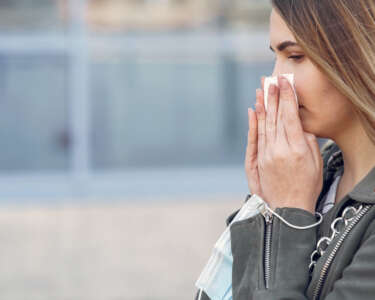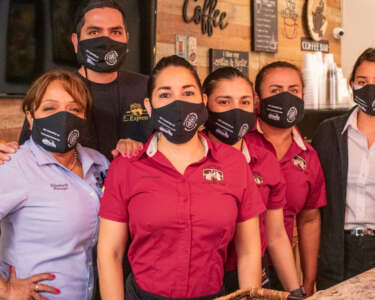Coronavirus has made everything a bit weird. We no longer can drink coffee with people we like, we can’t hug the people we love, and we can’t even leave our house with no risk of infection. Just like anything else, working in an office is not safe today, unless all of the safety measures have been taken. That means making sure everyone is socially distanced, appropriate PPE is worn and every surface is clean, however, cleaning a whole office top to bottom can be tough so using santa clarita covid 19 sanitizing services is a great way to keep the space clean and safe. If you’re looking for a way to create a safe and risk-free environment for your workers and your client, make sure to check out this guide and do your best for your company and all of its employees.
Prepare everything for the employees to come back to the office
You need to start thinking about the safety of your workers even before they step into the office. Namely, there are a couple of things you are supposed to do in advance that will make everything a lot easier later. Here is how to start your preparation.
Access the risk level in the workplace
The first thing you need to do is acknowledge what kind of risk you and your people are facing. There are jobs that are marked as lower exposure risk jobs, which means that people in these positions don’t have contact with people who are known to be or suspected to be infected with the coronavirus. They aren’t even in close contact with the general public. Since they have minimal contact with other employees or the public, these workers face a low risk of getting infected.
The other sort of job is the so-called medium exposure risk job which includes people who have frequent and close contact with people potentially infected with coronavirus, especially with those who aren’t known or suspected patients. When there is no ongoing community transmission, workers usually have contact with travelers from international locations and when there is ongoing community transmission, workers have contact with the general public, as in schools or high-population-density work environments.
It’s important to understand the type of risk your workers face in order for you to protect them properly. Depending on their jobs, you’ll be able to access the problem as you should and do the most for everyone’s safety.
Obtain protective equipment
After you’ve accessed the risk, you can successfully move to obtain the equipment you need to protect everyone in the company. There are a couple of requirements your equipment needs to meet. For instance, you should select protective equipment based on the hazard you’ve previously examined. That is exactly why it is important to access the risk level in the workplace.
Another thing you should do is make sure that the protective equipment is fitted and refitted as applicable. After that, it’s essential to ensure that the equipment is worn whenever necessary and in the right way. The equipment should be regularly inspected, maintained, and replaced if needed. It should also be removed, cleaned, and stored properly in order for contamination to be completely avoided.
Masks are some of the essential parts of any responsible community and that is exactly why your workers should have masks available whenever they come to work. All workers should have their own hand sanitizers and stations throughout the workplace should include hand sanitizers as well. Place these at every entry and exit point as well. Finally, make sure to have disposable toilet seat covers in the bathrooms.
Prepare the physical workplace
You should prepare the office in order to create a safe working environment. There are certain protective measures you should take before you welcome the workers back into the office. For instance, you should close some of the common areas – cafeterias, conference rooms, and other collaborative spaces. Another solution would be to socially distance them, which is a very good idea. With some social distancing floor stickers, you can make sure that your workers never cross the recommended distance among them. Although it may seem tough at first, the idea of social distancing is far better than the idea of contracting Covid-19. Recommended distances between employees are 6 feet or 2 meters, and these rules should be followed at all times. You can rearrange offices for social distancing by moving desks and seats, blocking off certain toilets, and sinks if they’re too close together, and encouraging people to bring in their own food and drinks so people don’t congregate at a fridge or water fountain. Hygiene services can help you make sure your office is safe for employees.
Elevators, stairwells, and hallways are other spaces in which people can experience close contact. To solve this problem, you can introduce one-way protocols. Make sure that the areas are well-ventilated. You can do this with the help of some high-efficiency air filters. Using some physical barriers, such as clear plastic sneeze guards, you can also protect the workers from contamination. You can find such products at https://www.versare.com/countertop-screens-and-shields/. No-touch trash cans are also great for achieving this goal. Make sure to address every space in the company, especially the ones with high traffic.
Make some schedules
If you have too many workers in the company, it can get a bit tricky protecting all of them, for that very reason, you should make some new schedules and determine who is coming in and when. The key here is to be as flexible as possible. You should think of the remote workers as well and decide whether they should continue working like that or not.
You should divide the employees into several groups depending on their work station. Make sure that the groups are rotating and that way, you’ll easily maintain the social distance rules. Depending on the workplace layout and the volume of the employees, you should come up with a suitable schedule.
You can also designate shifts and stagger start times to avoid workers having contact in entryways or elevators. That way, they’ll always be at the recommended 6-to10-foot distance from each other. The employees who rotate tasks usually should be assigned to one location per shift. Finally, ponder whether your employees need public transportation alternatives.
Screen employees before getting them back to the office
You should remember that there is a large number of asymptomatic COVID-19 patients. For that reason, you should screen your employees, which will reduce the risk to the minimum. They can either bring a negative COVID-19 test or they could answer a questionnaire that will give you an insight into their health.
Prepare the employees
In the end, you can do your best to raise awareness among your workers. Make sure to establish the new policies and distribute them to the workers in advance. Don’t wait for them to return to work to present them with the changes. Make sure to inform them about the necessity of the masks. You should develop a written policy that will contain all of the details relating to the potentially infected employees.
The employees should know whether the workplace will be closed in case of contamination. There should be a protocol regarding cleaning between shifts and there should be protocol regarding the number of people in restrooms. If you close the cafeteria, make sure the employees can pick up their lunch at separate times. You can even set up a delivery system to avoid contact altogether.
Make sure to minimize business travels. Whenever there is non-essential business travel, cancel it. Even if travel is necessary, you can minimize the risk by considering travel by car. Think of other options to promote and practice social distancing. For instance, organize video conferences rather than the ones in person.
Screen employees onsite
Finally, make sure that you’re letting in healthy workers. The best way to do so is to screen them onsite. Before they enter the premises, they should go through a screening station. The best place for a screening station is at the entryway. You should have a trained individual that would regulate the situation there. It’s best to have a third party doing this job to avoid any possible infection at the workplace.
The individual at the screening station should take temperatures and go through some questions with the employees. You should have the questionnaire prepared in advance and it should contain questions such as whether they’ve been self-isolating, whether they have been tested for coronavirus, and whether they’ve had any of the symptoms. Depending on the answers, you’ll know whether to invite the workers in or to send them back to remote working.
Conclusion
It’s not easy working at the time of a global pandemic. However, it’s possible. All you need to do is get informed on the virus and the ways to protect yourself and your workers from infection. With this thorough guide, you’ll be able to keep the safety at a maximum level and protect everyone who steps into your company.














 Deering Estate
Deering Estate
 Massage Envy South Miami
Massage Envy South Miami
 Calla Blow Dry
Calla Blow Dry
 My Derma Clinic
My Derma Clinic
 Sushi Maki
Sushi Maki
 Sports Grill
Sports Grill
 The Healthy Kitchen
The Healthy Kitchen
 Golden Rule Seafood
Golden Rule Seafood
 Malanga Cuban Café
Malanga Cuban Café

 Kathleen Ballard
Kathleen Ballard
 Panter, Panter & Sampedro
Panter, Panter & Sampedro
 Vintage Liquors
Vintage Liquors
 The Dog from Ipanema
The Dog from Ipanema
 Rubinstein Family Chiropractic
Rubinstein Family Chiropractic
 Your Pet’s Best
Your Pet’s Best
 Indigo Republic
Indigo Republic




 ATR Luxury Homes
ATR Luxury Homes


 2112 Design Studio
2112 Design Studio
 Hamilton Fox & Company
Hamilton Fox & Company
 Creative Design Services
Creative Design Services
 Best Pest Professionals
Best Pest Professionals
 HD Tree Services
HD Tree Services
 Trinity Air Conditioning Company
Trinity Air Conditioning Company
 Cisca Construction & Development
Cisca Construction & Development
 Mosquito Joe
Mosquito Joe
 Cutler Bay Solar Solutions
Cutler Bay Solar Solutions


 Miami Royal Ballet & Dance
Miami Royal Ballet & Dance
 Christopher Columbus
Christopher Columbus
 Pineview Preschools
Pineview Preschools
 Westminster
Westminster
 Carrollton
Carrollton
 Lil’ Jungle
Lil’ Jungle
 Frost Science Museum
Frost Science Museum
 Palmer Trinity School
Palmer Trinity School
 South Florida Music
South Florida Music
 Pinecrest Orthodontics
Pinecrest Orthodontics
 Dr. Bob Pediatric Dentist
Dr. Bob Pediatric Dentist
 d.pediatrics
d.pediatrics
 South Miami Women’s Health
South Miami Women’s Health

 The Spot Barbershop
The Spot Barbershop
 My Derma Clinic
My Derma Clinic




 Miami Dance Project
Miami Dance Project

 Rubinstein Family Chiropractic
Rubinstein Family Chiropractic
 Indigo Republic
Indigo Republic

 Safes Universe
Safes Universe
 Vintage Liquors
Vintage Liquors
 Evenings Delight
Evenings Delight





 Atchana’s Homegrown Thai
Atchana’s Homegrown Thai
 Baptist Health South Florida
Baptist Health South Florida

 Laser Eye Center of Miami
Laser Eye Center of Miami
 Visiting Angels
Visiting Angels
 OpusCare of South Florida
OpusCare of South Florida

 Your Pet’s Best
Your Pet’s Best





 HD Tree Services
HD Tree Services
 Hamilton Fox & Company
Hamilton Fox & Company


 Creative Design Services
Creative Design Services